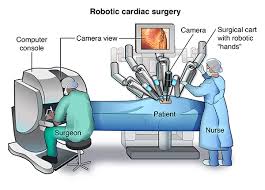Robotic surgery for cardiac is a form of heart surgery performed through tiny incisions in the chest. The procedure is sometimes called da Vinci surgery because that is the name of the manufacturer of the robot often used for this procedure Robotic surgeries have been used for a number of different heart-related procedures, including mitral valve repair, coronary artery bypass, heart defect repair, and tumor removal.
Robotic Heart Surgery in India is the latest and most advanced technique in the world to perform heart surgery with greatest precision Robot Assisted Heart Procedures are done to treat a variety of conditions:
• Mitral valve repair—surgery to repair problems with the valve between the upper and lower chambers on the left side of the heart
• Coronary artery bypass grafting (CABG)—surgery that creates a path around blocked heart vessels so that blood can reach the heart muscle. The bypass is done using blood vessels from other parts of the body to
Atrial septal defect repair—surgery to close a hole in the wall between the upper two chambers of the heart
• Biventricular pacemaker lead placement for heart failure—surgery to place leads (wires) on the inner surface of the heart’s ventricles. The leads are attached to a biventricular pacemaker to help the heart beat in a regular rhythm.

The da Vinci robot is a highly sophisticated tool that enables the surgeon to perform the procedure with greater precision and control than is possible in traditional hands-on surgery. In robotically assisted surgeries, the chest cavity is accessed through dime-size "keyhole" incisions.
The surgeon sits in a console equipped with controls that direct robotic arms to perform the surgery. The da Vinci's robotic arms are essentially an extension of the surgeon's hands. A tiny camera attached to a robotic arm gives the surgeon a very detailed, three-dimensional view of the operating space inside the chest. The robotic arms are very agile, providing the surgeon a greater range of motion than is possible with hand-manipulated moves in standard procedures

Minimally invasive surgery offers several advantages compared to open-chest procedures, including:
• Faster return to normal activities. Rather than waiting several weeks to heal, patients can return to work or other activities much more quickly--usually within 10 days.
• Shorter hospital stay. Time spent in the hospital can sometimes be reduced by as much at 50 percent, compared to open procedures.
• No splitting of the breastbone ("cracking the chest"). Keeping the breastbone intact reduces the chance for post-surgical complications and infection.
• Smaller incisions. Depending upon the case, the operation may be performed through four to five fingertip-size incisions or through a 3- to 5-inch incision at the side of the chest. Traditional open-heart procedures require a longer incision down the center of the chest.
• Significantly less pain. Decreased damage to tissue and muscle results in less pain. Tylenol or aspirin are often enough to manage pain after some procedures.
• Elimination of the heart-lung bypass machine, in most cases. Avoiding the bypass machine decreases the risks for neurological complications and stroke.
• Minimal blood loss and less need for transfusion.
• Little scarring. Instead of a long chest scar, only a few tiny scars or a short, 3- to 5-inch scar remains.

No comments:
Post a Comment